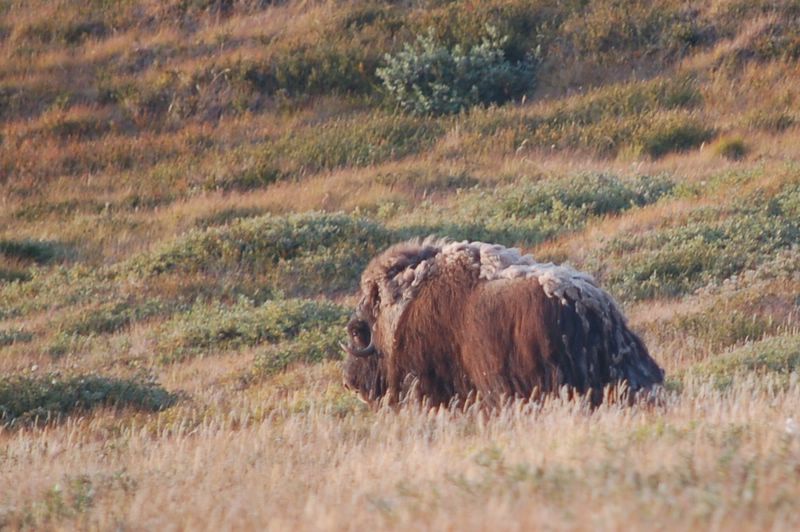
How to see musk oxes?

The first solution to see musk ox (umimmak; umimmaat) consist in paying for a musk ox safari. However, it is always written: "if we are lucky, we will see musk ox".
The second one consist in buying an "Umimak Baja", i.e. an aromatic greenlandic beer.
Still not satisfied ?
OK, ask for the areas where this species has been introduces. Kangerlussuaq is one of these. When I arrived, a German told me that they enjoy the South bank of Qinnguata Kuussua.
After a first failure at the beginning of my trip, I'm now with a firm will to find them.
In fact, the first failure was only partial. Indeed, although 150 m is considered as a security distance, I saw one, took pictures of it, and even touched it. You should admit that it looked friendly.

I'm leaving Kangerlussuaq with 5 days of food, ready to go up to the glacier, which is located 35 km from Kangerlussuaq as the crow flies.
However, after 5 km walk, still on the road, I see some suspect shapes on the other riverside. I go down the slope on 1 km. They are here.
About 10 umimmaat are drinking in the river.

What to do now ? I continue the trek without actual aim.
Umimmaat tracks
The first sign of umimmaat are the well marked trails. These tracks can easily be distinguished from those made by hiking clubs The latter build cairns or paint rocks.
Instead, umimmaat have 3 kind of mark:
| Foot-print |
Wool wisp (white, gray, black, brown or mixed) |
Dung (allows estimating whether their presence is recent or not). |
 |
 |
 |
Umimmaat trails are very useful for hikers. Their way is always remarkably well chosen, both when dealing with strong slopes and when crossing swamps and aquatic passages.
Nevertheless (I did not verify that by myself), if umimmaat come in front of you on THEIR path, they have right of way. They know it, and if you stay on THEIR way, one of them may teach you how to behave properly.
Meetings
Following the first watch on the other side of the river (1 km from me), the walk has been a succession of closer and closer meetings.
After having reach the summit of the plateau, I meet a herd 400 or 500 m from me. They saw me and went away.

I put my tent on the North bank of Store Saltsø. Some other umimmaat are on the East side of the lake.
I'm falling asleep hoping that a male will not take my tent for a rival or for a nice female.
When I go out of the tent the next morning, several umimmaat are taking their breakfast peacefully near the tent.
 |
 |
They look surprised to see me and go away.
The first action of the day was to go to take water in the next lake, i.e. where more drinkable water than Store Saltsø's water can be found.
However, given that I find one herd of about 10 oxes in each valley, the whole day is spent in crawling behind willows, watching oxes, and taking pictures.

I have spotted a herd behind the ridge of a mount. Hidden behind a rock, I watch them crossing the other side of the valley one by one. However, the bigest one is lacking. I climb the mount to see what he is waiting for.
When I arrive at the top, I understand what he was doing. I'm face to face with him. By chance, he was more affraid than me, turned back and ran away immediately. Because I was also "a bit" affraid, I took some time to take my camera.
3 o'clock in the morning, 1°C in the tent. I hear a great northern diver outside, then some geese, but it begins to be dark and I'm cold. I stay in bed.
In the morning, I go to take water in the next lake. There are no umimmaat anymore, but I see a new unknown little animal in the lake.
A trilobite ? I will find the same animal in another lake 3 days later: a Lepidurus arcticus. But this is another story.
I close my bag and come back to Kangerlussuaq, with the aim to take the direction of Sisimuiut the next morning in order to try new trail variants.
